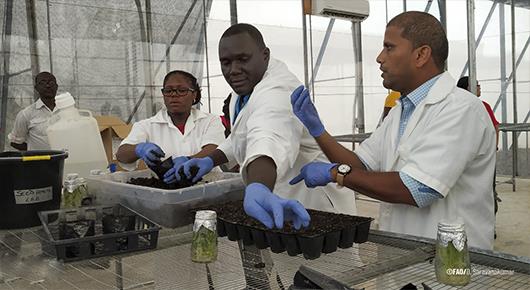Harnessing new technologies to rebuild an industry

For many, Jamaican ginger beer, ginger tea or ginger biscuits are a household staple. This Caribbean island has long had a global reputation for its excellent ginger, known for its potency and pungency – but the industry is being threatened.
Ginger Rhizome Rot (GRR) disease has for years devastated production across the island and even caused many farmers to stop ginger production altogether. The disease has been so prominent that, between 2015 and 2018, Jamaica’s ginger production dropped by almost half.
However, thanks to new and innovative technologies, and a highly motivated band of public and private sector workers called the Ginger Working Group, the country is well on its way to revitalizing the industry and returning Jamaican ginger to prominence on the global market.
The Strategy and the Technology
With FAO’s help, the Ginger Working Group put together a long-term strategy to resuscitate the industry. The strategy for industry resuscitation relied on operationalising a commercial certification system to generate clean planting material and maintaining strict field protocols to reduce the risk of disease.
As a third step for the group would be the design of a business model based on a public-private partnership to implement a clean seed certification programme which involves public tissue culture laboratories and field research stations, as well as commercial nursery operators, farmers and agro-processors. But first, the team would have to ensure that the country could consistently and sustainably produce disease-free ginger from clean tissue culture.
Through FAO’s technical assistance, the country has multiplied disease-free quality planting materials using an innovative mass propagation technique called the single bud nursery technology. The technology, which is used in India, reduces the cost of planting material, which farmers must buy every year, by up to 75 percent. The technology, which requires significant training to ensure its successful application, provides a means of multiplying the limited available clean planting material and its propagation under nursery conditions. This technology forms the basis of the ginger certification programme and when supported by Good Agriculture Practices (GAPs) should help ginger growers boost their levels of production.
“One of the most notable aspects of the workshop was learning about the single bud nursery technology to help in minimizing the attack of the rhizome rot” remarked Dr Seymour Webster, Head of Department of the Plants, Soil Sciences and Engineering at the College of Agricultural Science and Education (CASE). He added that the “quality of the assistance provided by FAO in reviving the ginger sector has been invaluable and insight gained from the workshop was a propelling factor to “operationalise a section of the college’s greenhouse for nurturing ginger tissue culture and offer training in the propagation of clean ginger plantlets”.
Over the last couple of years, FAO has also been providing training sessions for government agencies, nursery workers and farmers on good agricultural practices to increase the production of clean, disease-free ginger. FAO has now trained two government agencies within the Ministry of Agriculture and Fisheries to provide technical support too. Trained staff from these two agencies will now train nursery workers and farmers to follow the correct protocols to keep the disease at bay.
“Technical support to our ginger farmers to ensure that they can produce sustainably and under disease-free conditions is very important” says Gusland McCook, the Acting Director General of one of the involved government agencies. With an increased potential to produce quality ginger, local farmers are able to increase their production capacity and earning potential, thereby contributing to a growth in the ginger industry and the country’s economy.
Bringing back Jamaican ginger
With FAO’s support, the rehabilitation of green houses for growing and housing ginger tissue culture has also been completed allowing new plantlets, free from GRR disease, to be developed and mass multiplied in nurseries through single bud technology before being purchased by farmers for cultivation. This has allowed the country to make greater strides in ginger production.
To date, the group’s biggest success has been the commercialization of the certification programme including a traceability system to see who buys the product. The programme will help to ensure the quantity, quality and diversity of Jamaican ginger products and provide security and incentive to local and international buyers whilst adding value to Jamaican ginger on the global market.
“Jamaica has great potential to re-enter the global market as a top producer of quality ginger. It may take few years for the country to produce quality ginger at its fullest potential; but a robust certification system, including incentives and support for planting and production of disease-free material, increased support to developing the industry and adherence to the technical guidelines for producing quality ginger is crucial” says FAO expert Plant Pathologist Prof Duraisamy Saravanakumar, who delivered training in the use of the technology.
Through collaboration and the use of innovative methods, FAO has been able to support the Jamaican Government in revitalising its ginger industry. The knowledge gained in redeveloping the ginger industry is now being used as a scalable blueprint for building the country’s turmeric industry, proving once again that there are no limits to well harnessed innovations.
Original Story: Banding together to re-root the Jamaican ginger industry
Website: FAO Jamaica, the Bahamas and Belize
